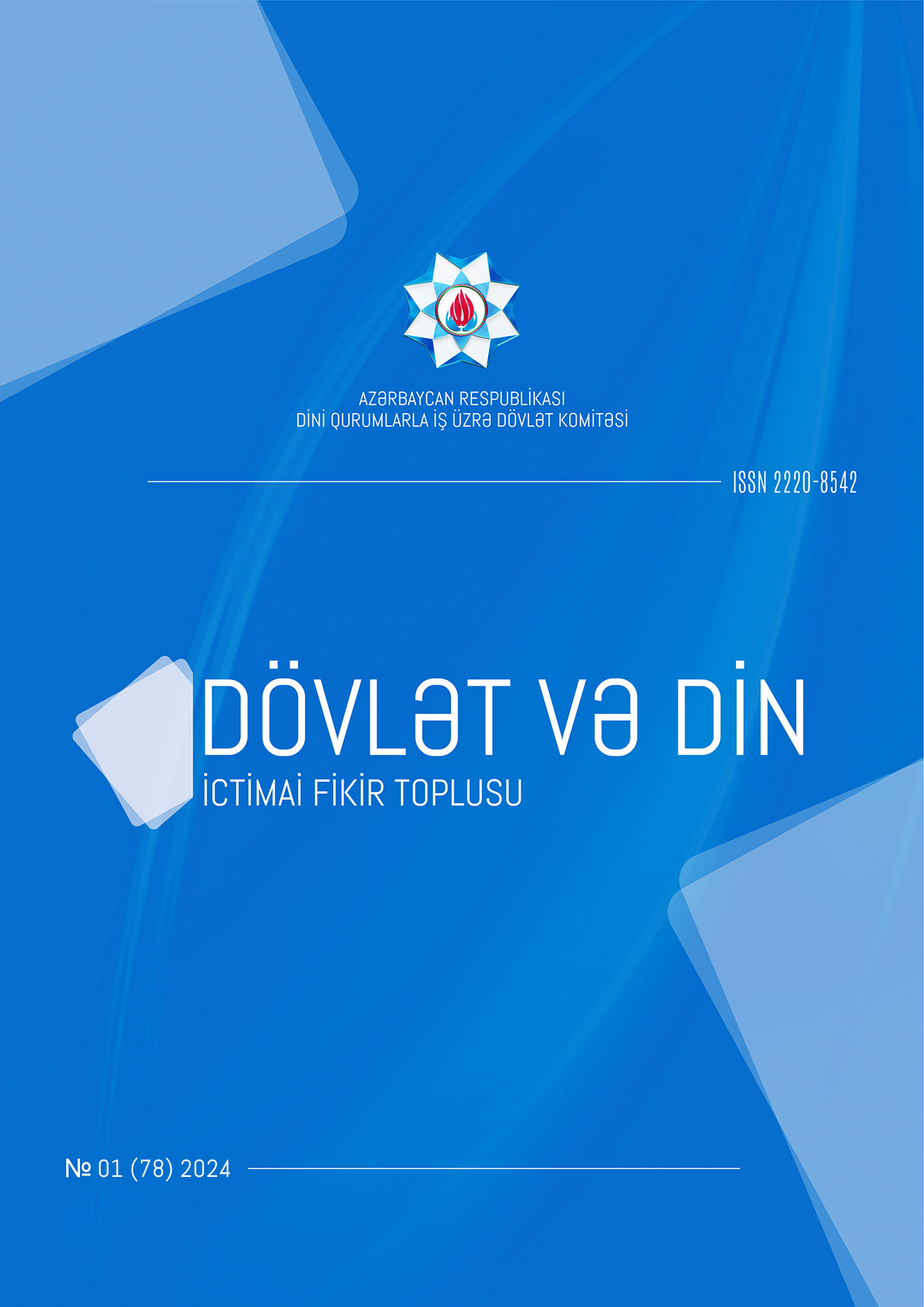VƏHDƏTİ-VÜCUD: ŞƏRQ VƏ QƏRBİN VƏHDƏTİ KİMİ
Zaur Rəşidov | zaur20@mail.ru
AMEA-nın Fəlsəfə və Sosiologiya İnstitutunun “Azərbaycan fəlsəfə tarixi” şöbəsinin böyük elmi işçisi, fəlsəfə üzrə fəlsəfə doktoruTarixə pəncərə
ƏDƏBİYYAT
1. Nasr S.H. Islamic Life and Thought. Albany: State University of New York Press, 1981, 232 p.
2. Houben H. Roger II of Sicily: A Ruler between East and West. Cambridge: University Press, 2002,
231 p.
3. Metcalfe A. Muslims and Christians in Norman Sicily: Arabic-Speakers and the End of Islam. New
York: Routledge, 2003, 286 p.
4. Burnett C. Arabic into Latin: the reception of Arabic philosophy into Western Europe // The
Cambridge Companion to Arabic Philosophy. Cambridge: University Press, 2005, p. 370-404.
5. Məmmədov Z. Azərbaycan fəlsəfəsi tarixi. Bakı: Şərq-Qərb, 2006, 328 s.
6. Erdem H. Bir Tanrı-Alem Münasebeti Olarak Panteizm ve Vahdet-i Vücud. Ankara: Kültür ve
Turizm Bakanlığı Yayınları, 1990, 126 s.
7. Nasr S.H. Islamic Philosophy from Its Origin to the Present: Philosophy in the Land of Prophecy.
New York: State University of New York Press, 2006, 380 p.
8. İpek A. Vahdet-i Vücut. İstanbul: Timaş Yayınları, 1992, 110 s.
9. Laliwala J.I. Islamic Philosophy of Religion: Synthesis of Science Religion And Philosophy. New
Delhi: Sarup & Sons, 2005, 226 p.
10. Geoffroy E. Introduction to Sufism: The Inner Path of Islam. Bloomington: World Wisdom, 2010,
219 p.
11. Mysticism in East and West: The Concept of the Unity of Being // Compiled and edited by Stamer
H. Lahore: Multimedia Affairs, 2013, 296 p.
12. Afifi E.A. Muhyiddin İbnü’l-Arabi’de Tasavvuf Felsefesi. İstanbul: Kırkambar Yayınları, 1999, 253
s.
13. Hameed S. Wahdat al-Wujud and the Holy Qur’an // Mysticism in East and West: The Concept of
the Unity of Being. Lahore: Multimedia Affairs, 2013, p. 59-67.
14. İbn Arabi M. Fütuhat-ı Mekkiyye Cilt I / Çevirmen E.Demirli. İstanbul: Litera Yayıncılık, 2015,
487 s.
15. Nicholson A.R. Studies in Islamic Mysticism. Cambridge: University Press, 1921, 282 p.
16. D’ancona C. Greek into Arabic: Neoplatonism in translation // The Cambridge Companion to
Arabic Philosophy. Cambridge: University Press, 2005, p. 10-31.
17. Маковельский А.О. Древнегреческие атомисты. Баку: Издательство АН Азербайджанской
ССР, 1946, 401 c.
THE UNITY OF BEING (WAHDAT AL-WUJUD) AS THE UNITY OF EAST AND WEST
Zaur Rashidov | zaur20@mail.ru
AMEA-nın Fəlsəfə və Sosiologiya İnstitutunun “Azərbaycan fəlsəfə tarixi” şöbəsinin böyük elmi işçisi, fəlsəfə üzrə fəlsəfə doktoruWindow into History
SUMMARY
The article considers the problem of the unity between East and West in the example of the Sufi
doctrine wahdat al-wujud. And also analyzes the Islamic and non-Islamic sources that influenced the
formation of this Sufi teaching. Since the end of the XIX and the first half of the XX century, Western
scholars have increasingly begun to show more interest in Sufism. According to many outstanding
European scholars, this teaching has immediate western roots. As such roots, they especially distinguished
pantheism, which manifested itself in various schools of Ancient philosophy. On the contrary, Islamic
scholars of the XX century believed that Sufism and its main teaching, wahdat al-wujud, had nothing in
common with Western spiritual culture. According to them, Sufism and the doctrine of the unity of being
is the brainchild of Islam and the basis of wahdat al-wujud is the dogma of the indivisible oneness and
unity of God or one of the basic principles of Islam, tawhid
REFERENCE LIST
1. Nasr S.H. Islamic Life and Thought. Albany: State University of New York Press, 1981, 232 p.
2. Houben H. Roger II of Sicily: A Ruler between East and West. Cambridge: University Press, 2002,
231 p.
3. Metcalfe A. Muslims and Christians in Norman Sicily: Arabic-Speakers and the End of Islam. New
York: Routledge, 2003, 286 p.
4. Burnett C. Arabic into Latin: the reception of Arabic philosophy into Western Europe // The
Cambridge Companion to Arabic Philosophy. Cambridge: University Press, 2005, p. 370-404.
5. Məmmədov Z. Azərbaycan fəlsəfəsi tarixi. Bakı: Şərq-Qərb, 2006, 328 s.
6. Erdem H. Bir Tanrı-Alem Münasebeti Olarak Panteizm ve Vahdet-i Vücud. Ankara: Kültür ve
Turizm Bakanlığı Yayınları, 1990, 126 s.
7. Nasr S.H. Islamic Philosophy from Its Origin to the Present: Philosophy in the Land of Prophecy.
New York: State University of New York Press, 2006, 380 p.
8. İpek A. Vahdet-i Vücut. İstanbul: Timaş Yayınları, 1992, 110 s.
9. Laliwala J.I. Islamic Philosophy of Religion: Synthesis of Science Religion And Philosophy. New
Delhi: Sarup & Sons, 2005, 226 p.
10. Geoffroy E. Introduction to Sufism: The Inner Path of Islam. Bloomington: World Wisdom, 2010,
219 p.
11. Mysticism in East and West: The Concept of the Unity of Being // Compiled and edited by Stamer
H. Lahore: Multimedia Affairs, 2013, 296 p.
12. Afifi E.A. Muhyiddin İbnü’l-Arabi’de Tasavvuf Felsefesi. İstanbul: Kırkambar Yayınları, 1999, 253
s.
13. Hameed S. Wahdat al-Wujud and the Holy Qur’an // Mysticism in East and West: The Concept of
the Unity of Being. Lahore: Multimedia Affairs, 2013, p. 59-67.
14. İbn Arabi M. Fütuhat-ı Mekkiyye Cilt I / Çevirmen E.Demirli. İstanbul: Litera Yayıncılık, 2015,
487 s.
15. Nicholson A.R. Studies in Islamic Mysticism. Cambridge: University Press, 1921, 282 p.
16. D’ancona C. Greek into Arabic: Neoplatonism in translation // The Cambridge Companion to
Arabic Philosophy. Cambridge: University Press, 2005, p. 10-31.
17. Маковельский А.О. Древнегреческие атомисты. Баку: Издательство АН Азербайджанской
ССР, 1946, 401 c.
ЕДИНСТВО БЫТИЯ (ВАХДАТ АЛЬ-ВУДЖУД) КАК ЕДИНСТВО ВОСТОКА И ЗАПАДА
Заур Рашидов | zaur20@mail.ru
AMEA-nın Fəlsəfə və Sosiologiya İnstitutunun “Azərbaycan fəlsəfə tarixi” şöbəsinin böyük elmi işçisi, fəlsəfə üzrə fəlsəfə doktoruОкно в историю
РЕЗЮМЕ
В статье рассматривается проблема единства между Востоком и Западом на примере
суфийского учения вахдат аль-вуджуд. Также анализируются исламские и неисламские
источники, повлиявшие на формирования этого суфийского учения. Начиная с концов XIX и
первой половины XX века западные исследователи все чаще начали проявлять интерес к суфизму.
По мнению многих выдающихся европейских ученых, данное учение имеет непосредственные
западные корни. В качестве таких корней они особенно выделяли пантеизм, проявивший себя
в различных школах античной философии. Напротив, исламские ученые XX века считали, что
суфизм и основное его учение вахдат аль-вуджуд не имеют ничего общего с западной духовной
культурой. По их мнению, суфизм и доктрина единства бытия является детищем ислама и в этом
плане основу вахдат аль-вуджуд составляет догма о единственности и единстве Бога или же один
из основных принципов ислама таухид
ЛИТЕРАТУРА
1. Nasr S.H. Islamic Life and Thought. Albany: State University of New York Press, 1981, 232 p.
2. Houben H. Roger II of Sicily: A Ruler between East and West. Cambridge: University Press, 2002,
231 p.
3. Metcalfe A. Muslims and Christians in Norman Sicily: Arabic-Speakers and the End of Islam. New
York: Routledge, 2003, 286 p.
4. Burnett C. Arabic into Latin: the reception of Arabic philosophy into Western Europe // The
Cambridge Companion to Arabic Philosophy. Cambridge: University Press, 2005, p. 370-404.
5. Məmmədov Z. Azərbaycan fəlsəfəsi tarixi. Bakı: Şərq-Qərb, 2006, 328 s.
6. Erdem H. Bir Tanrı-Alem Münasebeti Olarak Panteizm ve Vahdet-i Vücud. Ankara: Kültür ve
Turizm Bakanlığı Yayınları, 1990, 126 s.
7. Nasr S.H. Islamic Philosophy from Its Origin to the Present: Philosophy in the Land of Prophecy.
New York: State University of New York Press, 2006, 380 p.
8. İpek A. Vahdet-i Vücut. İstanbul: Timaş Yayınları, 1992, 110 s.
9. Laliwala J.I. Islamic Philosophy of Religion: Synthesis of Science Religion And Philosophy. New
Delhi: Sarup & Sons, 2005, 226 p.
10. Geoffroy E. Introduction to Sufism: The Inner Path of Islam. Bloomington: World Wisdom, 2010,
219 p.
11. Mysticism in East and West: The Concept of the Unity of Being // Compiled and edited by Stamer
H. Lahore: Multimedia Affairs, 2013, 296 p.
12. Afifi E.A. Muhyiddin İbnü’l-Arabi’de Tasavvuf Felsefesi. İstanbul: Kırkambar Yayınları, 1999, 253
s.
13. Hameed S. Wahdat al-Wujud and the Holy Qur’an // Mysticism in East and West: The Concept of
the Unity of Being. Lahore: Multimedia Affairs, 2013, p. 59-67.
14. İbn Arabi M. Fütuhat-ı Mekkiyye Cilt I / Çevirmen E.Demirli. İstanbul: Litera Yayıncılık, 2015,
487 s.
15. Nicholson A.R. Studies in Islamic Mysticism. Cambridge: University Press, 1921, 282 p.
16. D’ancona C. Greek into Arabic: Neoplatonism in translation // The Cambridge Companion to
Arabic Philosophy. Cambridge: University Press, 2005, p. 10-31.
17. Маковельский А.О. Древнегреческие атомисты. Баку: Издательство АН Азербайджанской
ССР, 1946, 401 c.




